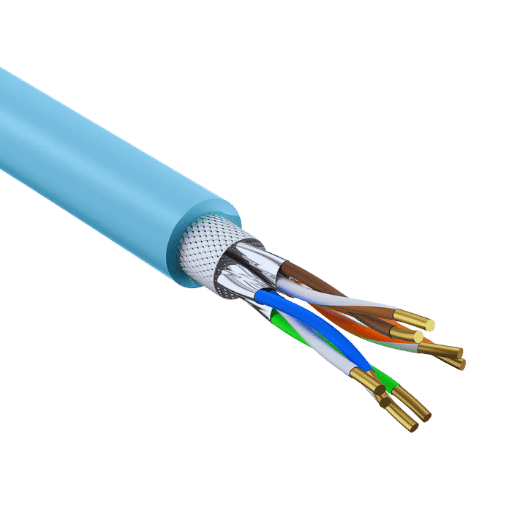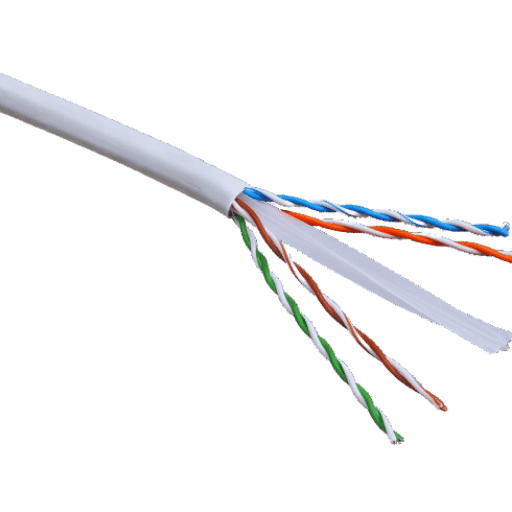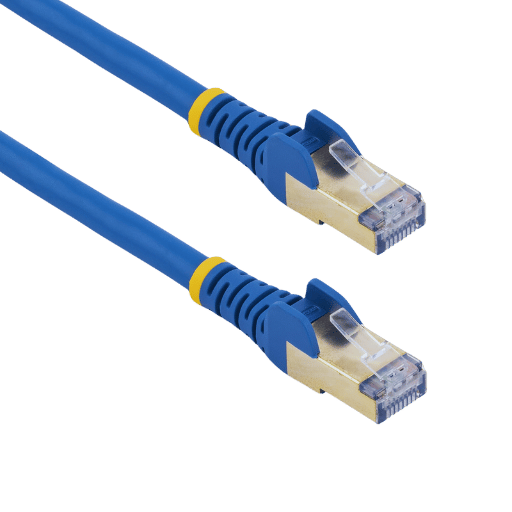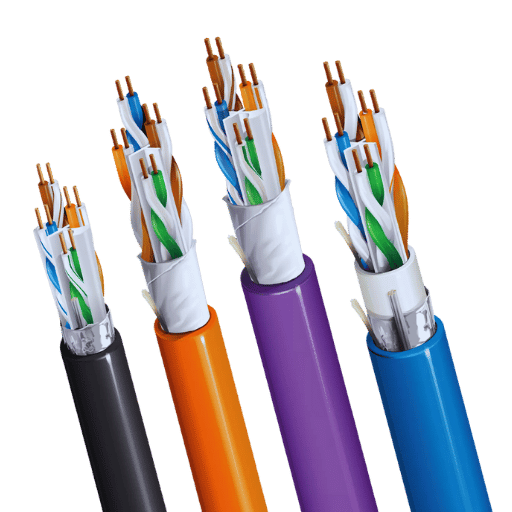The Cat6a Ethernet cable is much better than before, so it should be used in modern networks. First, the bandwidth can reach up to 500 MHz with Cat6a, twice that of Cat6 at 250 MHz. This means data can travel very quickly: 10 Gbps within a range of 100 meters. Additionally, crosstalk and electromagnetic interference (EMI) are significantly reduced by better shielding techniques in Cat6a, thus ensuring connections remain stable over time. Cat6a’s extra shielding is ideal for areas with lots of electric noise pollution! Furthermore, these cables work just as well with older types like Cat6 or 5e – so they integrate perfectly into any current network setup without causing issues – making upgrading easy! The bottom line is that if speed matters most to you, then go with this type because it not only outperforms others but also shields signals from outside disturbances better than them.

Ethernet cable, the Cat6a stands for Category 6a, is a more developed network wire that supports faster data rates and lessens noise than any other previous ETHERNET cables. This device can work with frequencies of up to 500 MHz while transferring information at speeds as fast as 10 Gbps within the range of 100 meters. The word “augmented” in its name means that it has better performance features than other models, mainly due to additional shielding against cross talk and electromagnetic interferences (EMI). Therefore, this cable type is best suited for environments with harsh conditions where strong connections are needed at high speeds only.
From what I’ve seen, there are two main differences between Cat6 and Cat6a cables. The first difference is their performance characteristics, and the second is their physical features. In terms of performance, these cables differ in terms of what they can do and how well they can do it, such as supporting 10-gigabit data transmission. For example, a typical Cat6 cable has a maximum speed capability of 1 Gbps at 250 MHz, so it can transmit data packets at 55 meters when used for 10 Gbps connections (the fastest available). This also makes them suitable for small office networks or homes where most devices don’t need anything faster than this. The other cable type – the augmented version – is designed with higher capacity for those who have huge data flow, such as server centers or storage facilities, etc. Such Augmented Category 6 cables can support speeds up to 10 Gbps over distances of 100 meters without any loss in signal quality because they employ shielding techniques not found in regular versions (Cat5e). This makes them ideal for environments where near-end crosstalk might be likely to occur, such as factories or hospitals. Furthermore, compared against each other on this basis alone will leave one wanting more. Still, we’ll add another reason why you should choose Cat Six A over its older sibling if your goal is future-proofing connectivity solutions between endpoints within any given network infrastructure that may arise later down the line causing bandwidth demands to grow exponentially beyond current expectations i.e.,, it’s The other cable type – the augmented version – is designed with higher capacity for those who have huge data flow, such as server centers or storage facilities, etc. aid “better safe than sorry.”
I found that Cat6a Ethernet cables are the best option for many applications, whether they be personal or professional, because of their improved performance and reliability. These cables can be used first in data centers where rapidity and frequency of data transfer are critical to good server and storage performance. Another common use for them is enterprise networks, specifically office buildings or college campuses with large numbers of devices requiring constant internet connection speeds. Lastly, in advanced home networking environments such as smart homes where multiple high-bandwidth devices need to communicate with each other at once (also known as being interconnected), having different types of wires like these could provide seamless connectivity while future-proofing infrastructure. All three of these examples demonstrate just how versatile and robust this type of wire really is when it comes to meeting current needs and those that may arise later on in time concerning networks, generally speaking.

Shielded Cat6a cables, such as Monoprice Cat6a, are advantageous in areas with high electromagnetic interference (EMI). This is the number one thing these wires do; they shield against EMI better than anything else. Because of this, it is not unusual for them to be used in industrial settings or places where there might be a lot of electrical noise. Moreover, the signal integrity is improved by shielded Cat6a cables because they minimize crosstalk and internal noise, leading to more reliable 10-gigabit data transmission. Therefore, overall network performance is enhanced, resulting in lower error rates, thus ensuring efficiency and reliability of communication within such high-demand environments like data centers, healthcare facilities, and manufacturing plants. In conclusion, shielded Cat6a cables are designed strong enough and hence can last longer than other types, thereby being considered cost-effective options for infrastructural investments over time.
Unprotected Cat6a cables are usually advised for atmospheres with minimal electromagnetic interference (EMI). These wires are less complex and more adaptable than shielded cables, which makes them easier to install and maintain. So, it is highly suitable for homes or average workplaces without EMI. Moreover, the price of Cat6a unshielded cables is lower; therefore, it can be chosen by those who have limited financial resources. In general, they provide good performance for common network applications at a reasonable cost without shielding complexity or additional expense.
Cable shielding involves surrounding wires with a conductive or semi-conductive material to prevent electromagnetic interference (EMI) and crosstalk. A layer is added to protected cables, usually made from braided copper or aluminum foil, like in Monoprice Cat6a cables, preventing external EMI from corrupting data transmission. Without them, it would be impossible to operate in places with high levels of electrical noise, like industrial complexes or data centers. On the other hand, unprotected cables do not have this additional safeguard, meaning they are cheaper and more flexible but also more susceptible to EMI, thus only suitable for environments without electromagnetic interference. Knowing what kind of setting you’re working with can help decide whether shielded or unshielded Cat6a cables would be better for your situation.

I must have specific tools when I install bulk Ethernet cables, such as Monoprice Cat6a cables. These are:
With these tools available, the installation process becomes more efficient while ensuring a professional setup.
By strictly following these steps, I can install a reliable and good Cat6a bulk cable.
If you follow these tips, not only will your job go smoothly, but also savings in time, energy, money, and resources can be achieved while getting better results from the networks installed

There are many benefits to using Shielded Cat6a Ethernet cables in high-speed or high-reliability network environments. First and foremost, the shielding reduces electromagnetic interference (EMI) and crosstalk, which improves signal integrity, enabling data transmission rates of up to 10 Gbps over distances of 100 meters. This is particularly useful in industrial areas where there may be a lot of cables close together or other nearby sources that cause this type of interference. In addition to this, improved overall performance and stability are achieved with shielded CAT6A cable, as it ensures a consistent flow of information through the system while keeping latency at its lowest possible level. These characteristics, therefore, make it perfect for use in data centers, server rooms, and high-performance computing networks, among others, since these places demand higher bandwidth but lower noise floors.
EMI is reduced in Cat6a cables by shielding them with conductive or magnetic casings around the wires that carry signals. Such casing stops outside electric fields from affecting data signals and inhibits internal ones from releasing EMI, which might disrupt neighboring electronics. The shields could be foil, braided metal, or both integrated at different strengths. When you lower EMI levels like this, it greatly enhances the dependability as well as the integrity of data transmission, which guarantees fast, stable network performance.
As a general rule, it is mostly suggested that shielded cable be used instead of unshielded cable in places with a lot of electromagnetic interference, like factories or industrial areas where many electronic devices work near each other. Another place where shielded cables come in handy is data centers, server rooms and high-performance computing networks that need fast rates of data transfer coupled with low delays. Moreover, they are suitable for applications with long stretches of cables, which must maintain signal integrity and reliability throughout. In conclusion, therefore, wherever better noise immunity is required together with improved reliability during transmission, it should call for the use of shielded cables.

Regarding conductors, 23AWG is the wire gauge used in Cat6a cables. The number 23 represents the diameter of the conductor in this case, generally, AWG numbers get lower as wire thickness increases. Thicker than those found within Cat5e or Cat6, which usually are constructed from either 24AWG or 26AWG wires, respectively, it becomes apparent that a 23AWG wire has a bigger diameter. This feature is essential for reducing resistance and providing excellent signal integrity over longer distances while supporting better performance capabilities achieved by higher bandwidths and improved attenuation characteristics available with Category-6a (CAT6A) cabling standards because its larger size decreases electrical impedance between connections – thus allowing more powerful signals through without loss – making it an indispensable requirement for modern high-speed networks.
Ethernet cables must contain copper conductors because they have better electrical conductivity than other materials. Among other things, this ensures that signals are transmitted effectively. Copper also helps minimize signal loss and attenuation, preserving information as it travels along wires over greater lengths. Furthermore, it is durable yet flexible enough to be used in a wide range of networking settings – from basic home setups all the way up to enterprise-grade networks requiring high performance – where it consistently delivers reliable connectivity.
UL compliance shows that the Cat6a cable has undergone testing and certification by Underwriters Laboratories (UL) to verify its conformance with strict safety and performance requirements. This endorsement is very important since it ensures that the cable is fireproof, strong, and has good conductance of electricity. In terms of organizations, when they use UL-compliant cables, it means safer networking infrastructure, lesser chance for electric failures, and sustained fast speeds all through. It would be wise, therefore, for any person or entity to employ these kinds of wires in order to protect themselves against weak or insecure networks.

The Direct Burial Cat6a Cable is an Ethernet cable made to be installed underground. It can tolerate very rough weather without any extra protection; thus, no conduit is required. They are made with a strong structure, including a heavy coat that protects against water damage, heat damage due to extreme temperatures, other harmful elements caused by moisture, etc. Furthermore, sometimes, they have gel-filled cores or tapes that block water from entering them altogether. Such features make these cables perfect for use outside where durability over many years matters most, such as buried networks or linking structures between buildings.
The direct burial shielded Cat6a cables have been designed to be used for underground wiring without the need for extra conduit protection. This cable type is mainly used when network infrastructure has to stretch over outdoor spaces, such as linking different buildings in a school or providing network links within a large compound. The cables are made with shielding which protects against electromagnetic interferences (EMI) and radio frequency interferences (RFI) thus ensuring that data is transmitted stably and without interruptions. Also, these cables are strong enough and waterproof so as to resist damages caused by physical factors or moisture penetration; hence, they can be relied upon for underground applications in the long run. What comes out is a long-lasting, high-performance answer meeting the current needs of networking outside demands.

A: For data transfer at high speed, Cat6a Ethernet cables ensure excellent performance since they can support 10 Gigabit speeds over 100 meters. In addition, they have more effective shielding that minimizes interference, hence making the connection more stable. Furthermore, these wires have superior insulation properties and can be applied in places with high performance demands.
A: Despite having all the capabilities of standard ones, these slim versions are much thinner and flexible. This means you will not struggle so much during installation or management, especially with limited space, like in data centers or behind walls, when using snagless Cat6a unshielded cables.
A: With a unique type of insulation, plenum ones can be used inside air ducts (HVAC plenums) and other spaces through which ventilation is done, but flame resistance also has to be considered. On the contrary, riser cables are intended for vertical connections between different floors within the same building; they are not meant for use in plenum areas because their fire ratings may not meet those required by such locations, although typically risers have lower fire ratings than plenums; thus, cheaper.
A: Yes. Outdoor-rated Cat6a cable jackets are tough enough to withstand harsh weather conditions like rain or direct sunlight exposure. This is achieved by adding an extra layer of UV-resistant sheath, which protects against moisture penetration and temperature variations commonly experienced outdoors, making 6a Ethernet cables more durable.
A: UTP stands for Unshielded Twisted Pair, a common form of network cable. It’s essential because this design helps reduce interference between pairs, enhancing reliable transmission without additional shielding.
A: Cat6a Ethernet cables can support 10 Gigabit speeds up to 100 meters (328 feet) without much signal loss, which makes it an excellent choice for large-scale network deployments like those found in office buildings or data centers.
A: Both cables will enable gigabit transmission rates over short distances, but cat6a wires are faster because they can deliver up to ten times the speed of their counterparts for a maximum distance of 100m. Moreover, these wire varieties have different noise immunity levels and resistance values; therefore, cat6a should be used whenever necessary.
A: A patch cord, also known as a network patch cable, is a short cable connecting network devices. For example, you might use this type of cord to connect your computer to the router or switch with one end plugged into each device. These cords, including network patch cables, are commonly seen in data centers, offices, and home networks where quick connections between different pieces of hardware are needed.
A: Cat6a, including snagless versions, comes in various lengths depending on your needs. Some standard options include three-footers (3ft), five-footers (5ft), seven-footers (7ft), ten-footers (10ft), twenty-five footers (25ft), fifty-footers (50ft), and thousand-footer bulk rolls(1000ft). Thousand-footer bulk rolls of 6a Ethernet cables are helpful when doing custom installations where specific lengths may be required.
A: Yes, you can use Cat 5e, but it will be better if you use higher-rated cables such as Cat6a. These cables have more insulation and construction, making them suitable for carrying data and Power over Ethernet (PoE) over a single wire, such as IP cameras, wireless access points, or VoIP phones.